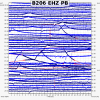Re: Scientists watch unusual Yellowstone quake swarm
Shiloh's reference discusses the "sudden appearanace" of those Yellowstone hotspots. I wonder what caused that? If those conditions should repeat, that may be the trigger for more activity in that area.
The seeming lack of explosiveness of the Hawaiian volcanoes is because they are shield volcanoes (fed by spreading plates).
We've got an area here (Wrangell volcanic field) that is being watched. They're inland volcanoes fed by the subduction of a small (as yet unnamed) plate with the source at the south end of Prince William Sound. They don't have the ash typical of a pyroclastic volcano, and are in fact one of the world's largest volcanic batholiths. A very large earthquakes here in 1964 "fired up" one of the volcanoes, that had been covered by ice for years. The caldera stays filled with warm water year round and it periodically steams. I lived nearby for a few years and watched the earthquakes in Prince William Sound often followed by small steam eruptions of that mountain.
.
Shiloh's reference discusses the "sudden appearanace" of those Yellowstone hotspots. I wonder what caused that? If those conditions should repeat, that may be the trigger for more activity in that area.
The seeming lack of explosiveness of the Hawaiian volcanoes is because they are shield volcanoes (fed by spreading plates).
We've got an area here (Wrangell volcanic field) that is being watched. They're inland volcanoes fed by the subduction of a small (as yet unnamed) plate with the source at the south end of Prince William Sound. They don't have the ash typical of a pyroclastic volcano, and are in fact one of the world's largest volcanic batholiths. A very large earthquakes here in 1964 "fired up" one of the volcanoes, that had been covered by ice for years. The caldera stays filled with warm water year round and it periodically steams. I lived nearby for a few years and watched the earthquakes in Prince William Sound often followed by small steam eruptions of that mountain.
.



 </CENTER></TD><TD width="50%">
</CENTER></TD><TD width="50%">




Comment